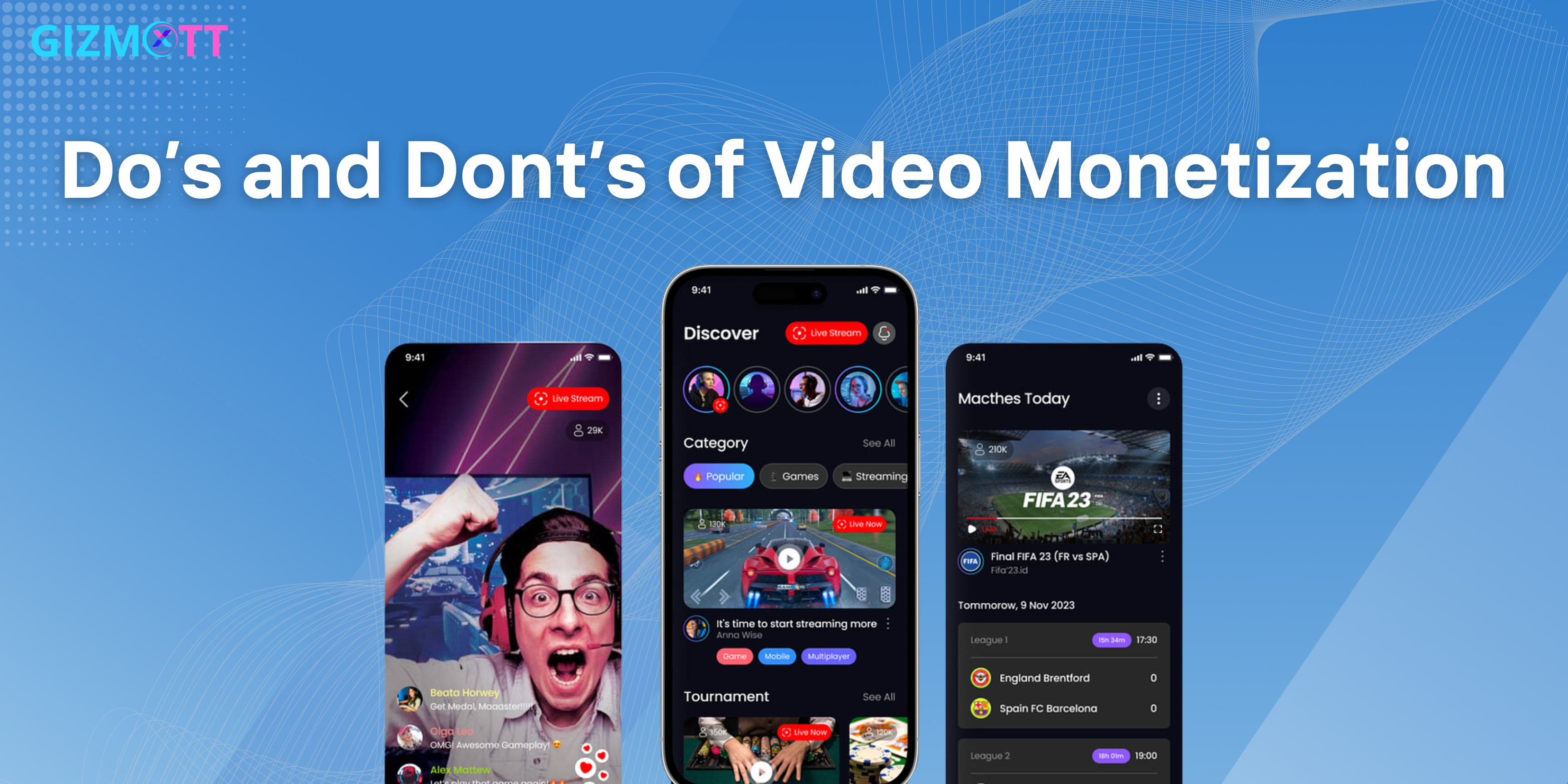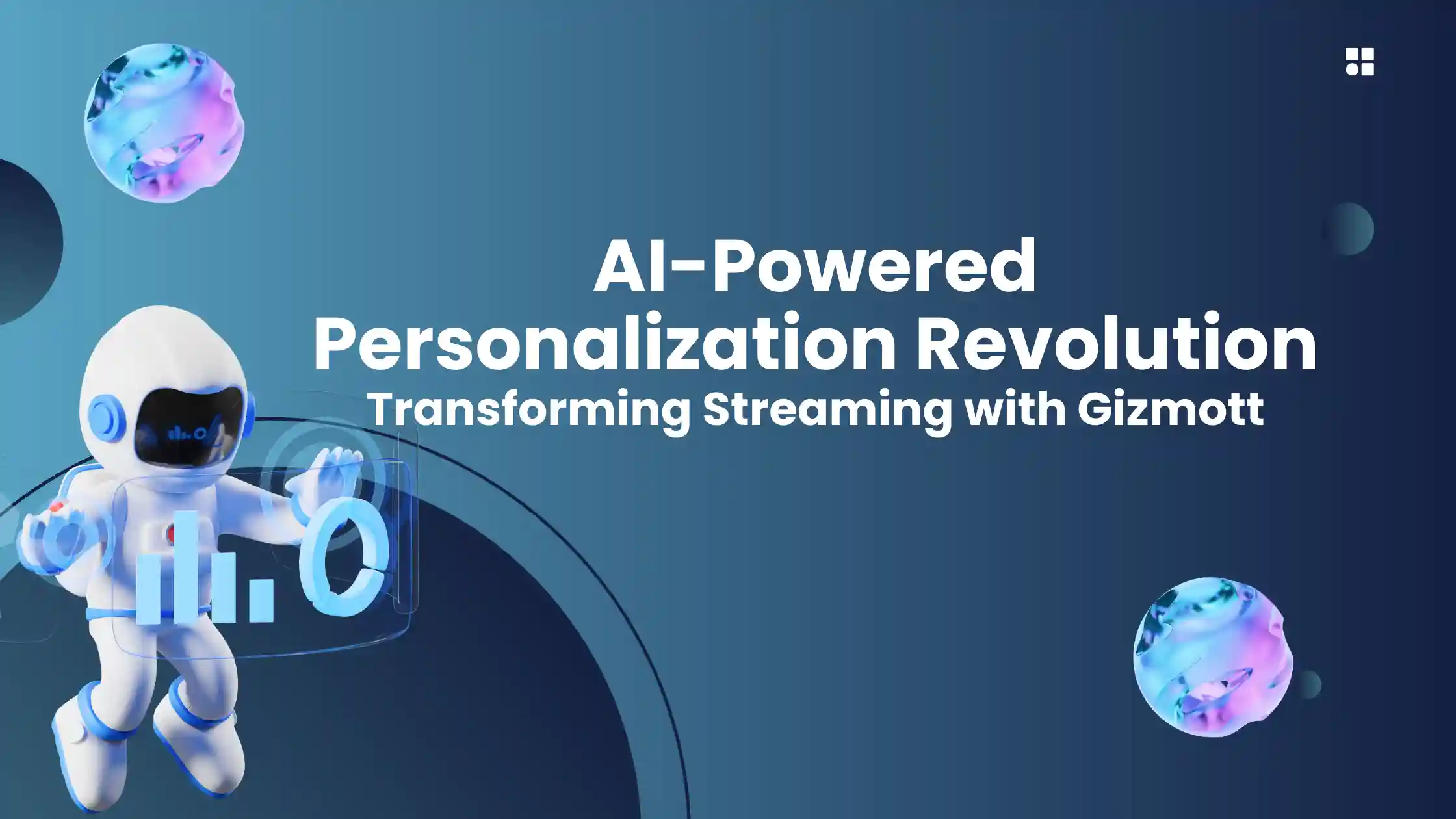Do’s and Don’ts of Video Monetization in Video Streaming Platforms: Best Practices, Mistakes & Future Trends
Introduction
In today’s fast-growing digital entertainment industry, video monetization has become the lifeline of every video streaming platform. As consumer demand for on-demand entertainment rises, platforms must implement effective video streaming monetization strategies to stay competitive and profitable. Whether you operate an ad-supported OTT service, a premium subscription network, or a hybrid platform, mastering the do’s and don’ts of video monetization is crucial for long-term success.
One powerful solution leading this transformation is Gizmott by Gizmeon, a next-generation OTT platform service provider that helps creators, broadcasters, and media companies launch, scale, and monetize video content seamlessly.
What Is Video Monetization and Why It Matters
Video monetization is the process of generating income from video content using ads, subscriptions, pay-per-view, sponsorships, or hybrid revenue models. Global reports predict the video streaming market will surpass $330 billion by 2030, with streaming revenue models growing at double-digit rates each year.
Effective video streaming monetization is not only about making money; it also sustains infrastructure, funds high-quality content, and fuels audience engagement. Platforms like Gizmott empower businesses to capture this opportunity by offering advanced tools for ad management, subscription billing, and content analytics, helping them optimize every revenue stream.
Do’s of Video Monetization in Video Streaming Platforms
1. Offer Diverse Monetization Options to Maximize Streaming Revenue
The most profitable streaming platforms rely on multiple streaming revenue models:
-
Subscription Video on Demand (SVOD): Recurring monthly or annual subscriptions for ad-free viewing.
-
Advertising Video on Demand (AVOD): Free content supported by relevant, non-intrusive ads.
-
Transactional Video on Demand (TVOD): Pay-per-view or pay-per-download pricing.
-
Hybrid Models: Combining ads and subscriptions for a wider audience reach.
-
Sponsorships & Partnerships: Collaborations with brands to drive additional income.
With Gizmott, OTT operators can mix and match these models—SVOD, AVOD, TVOD, or hybrid—ensuring maximum revenue from every viewer segment.
2. Prioritize User Experience for Better Retention
User satisfaction is at the heart of video streaming monetization. Seamless playback, minimal buffering, 4K quality, and intuitive navigation encourage longer watch times and repeat visits. Platforms that deliver smooth, personalized experiences, like Gizmott, enjoy higher engagement and improved monetization metrics.
3. Leverage Analytics to Optimize Monetization Strategies
Data-driven decisions are essential for successful video monetization. Analytics reveal which shows drive subscriptions, where viewers drop off, and which ads generate the best ROI. Gizmott’s built-in analytics dashboard provides real-time insights to optimize ad placement, pricing, and content delivery, ensuring higher conversions and revenue growth.
4. Experiment with Pricing and Promotions
Flexible pricing keeps audiences engaged and revenues growing. Test different subscription tiers, free trials, or bundle offers to find the ideal balance between affordability and profitability. Gizmott simplifies A/B testing and dynamic pricing, allowing you to adjust strategies based on real-time audience data.
5. Engage Viewers to Build Community Loyalty
Strong viewer engagement drives long-term monetization. Use interactive features such as live chats, comments, Q&A sessions, and exclusive content drops to foster community. Gizmott’s interactive tools, including live streaming support and social media integrations, make it easy to keep audiences engaged and eager to subscribe or watch ads.
Don’ts of Video Monetization in Video Streaming Platforms
1. Don’t Overload Viewers with Ads
Bombarding users with excessive ads reduces satisfaction and retention. Strategic, well-placed ads generate better revenue than aggressive ad loads. Gizmott’s intelligent ad-insertion technology ensures non-intrusive, highly targeted ads that enhance the viewer experience.
2. Don’t Neglect Content Quality
Low-quality videos or poorly matched ads can damage your brand. Prioritize HD or 4K content and ensure ad relevance. Gizmott supports adaptive bitrate streaming and enterprise-grade delivery, guaranteeing top-tier quality across devices.
3. Don’t Ignore Audience Feedback
User feedback is a goldmine for improving video streaming monetization. Viewers often share opinions on ad frequency, pricing, and content value. Platforms using Gizmott’s analytics can track churn rates and sentiment, responding quickly to maintain trust and loyalty.
4. Don’t Undervalue Premium Content
Avoid pricing premium content too low or offering it entirely free. Tiered pricing models and exclusive access options protect content value while driving conversions. Gizmott enables flexible premium pricing and paywall management to monetize high-value content effectively.
5. Don’t Fail to Adapt to Market Changes
The streaming market evolves rapidly with new ad formats, privacy regulations, and consumer preferences. Platforms that fail to adapt risk losing revenue. Gizmott provides regular updates and future-ready features to keep your OTT business competitive in a fast-changing environment.
Future Trends in Video Monetization
Hybrid Monetization Will Dominate
By 2028, more than 50% of streaming platforms will adopt hybrid models that combine ads with subscriptions, giving viewers the choice between lower-cost ad-supported plans or premium ad-free experiences.
Interactive and Shoppable Video Ads
Clickable shopping links and interactive ads are projected to contribute 20–30% of ad revenue within five years. Gizmott’s ad engine already supports these next-gen ad formats.
AI-Driven Personalization
Artificial intelligence will drive smarter ad placements, personalized recommendations, and dynamic pricing. Platforms using AI tools like those integrated in Gizmott can improve engagement and maximize video monetization.
Global Revenue Growth
The worldwide video streaming industry is forecast to surpass $330 billion by 2030, creating huge opportunities for platforms using advanced streaming revenue models. Subscription revenue alone is expected to grow by over 12% annually, while ad-supported streaming will capture a growing share of the market.
Why Gizmott Is the Smart Choice for OTT Monetization
Whether you are a broadcaster, media company, or independent creator, Gizmott by Gizmeon provides everything needed to launch and scale a profitable video streaming platform:
-
Flexible monetization models (SVOD, AVOD, TVOD, Hybrid).
-
AI-powered analytics for smarter decisions.
-
Secure payment gateways and scalable infrastructure.
-
Adaptive streaming for flawless quality.
-
Built-in tools for community engagement and live streaming.
With Gizmott, you can launch, grow, and monetize your streaming platform without the technical challenges and costs of traditional setups.
Conclusion
Mastering video monetization in the era of digital streaming requires a careful balance of user experience, content value, and evolving market trends. Platforms that embrace diverse streaming revenue models, leverage analytics, and engage audiences will thrive in the years ahead.
By partnering with Gizmott – The Top OTT Platform Service Provider, businesses gain access to future-ready OTT technology that simplifies video streaming monetization, supports hybrid models, and adapts to changing viewer preferences. Whether your goal is ad-supported growth, subscription success, or a combination of both, Gizmott equips you with the tools to maximize streaming revenue and build a sustainable, profitable platform.
What are the different monetization options available in video streaming platforms?
- Subscription-based access
- Pay-per-view (PPV) options
- Ad-supported models
- Sponsorship opportunities
How important is user experience in video streaming platforms for effective monetization?
User experience is paramount as it directly impacts viewer engagement and satisfaction, which in turn influences revenue generation.
Why is it crucial to leverage analytics in video monetization strategies?
Analytics provide valuable insights into viewer behavior, preferences, and engagement patterns, helping platforms tailor their monetization strategies for maximum effectiveness.
How can platforms experiment with pricing to optimize revenue generation?
Platforms can experiment with different pricing tiers, promotional offers, and bundling options to find the optimal balance between revenue generation and subscriber retention.
What are some effective ways to engage with viewers on video streaming platforms?
Engaging with viewers through interactive features like comments sections, live chats, and social media integrations fosters a sense of community and loyalty among the audience.
How can platforms avoid overloading viewers with ads?
By strategically placing ads, ensuring relevance, and limiting their frequency, platforms can prevent ad overload and maintain a positive viewing experience.
Why is it essential to prioritize quality control in video monetization strategies?
Poorly executed ads, low-quality content, and intrusive placements can damage a platform’s reputation and drive viewers away, underscoring the importance of quality control measures.
How should platforms respond to audience feedback regarding monetization practices?
Platforms should address concerns promptly, transparently, and implement changes based on feedback to maintain trust and credibility with the audience.
What strategies can platforms use to monetize high-value content effectively?should platforms respond to audience feedback regarding monetization practices?
Implementing tiered pricing structures, offering premium content, and exclusive access options are effective ways to monetize high-value content.
Why is it crucial for platforms to adapt to changing market dynamics in video monetization?
Adapting to evolving industry trends and consumer behaviors ensures platforms remain competitive and relevant, driving sustained growth and success in the long term.



